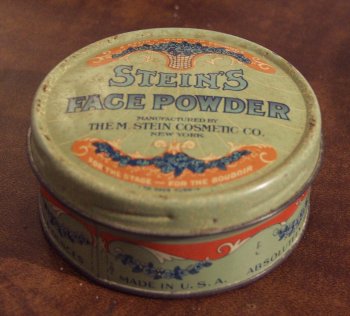 I have a modest collection of vintage vanity items; my collection and I have even been featured in Collectors News magazine. Included in my collection are various vintage powder tins, compacts, and refills.
I have a modest collection of vintage vanity items; my collection and I have even been featured in Collectors News magazine. Included in my collection are various vintage powder tins, compacts, and refills.
Once you get past the pretty packaging (which I’ll admit might take some time!), you notice the names of shades of old powders… And this can spawn a collection of its own: collecting vintage powders by name of the color (or shade) of the powder.
In fact, there’s quite a bit to learn in the dusty trail of vintage face powder names.
One of the most common vintage powder shades is Rachel; nearly every maker of face powders had a shade called Rachel, making it an easy entre into collecting by shade. Even if you don’t collect vintage cosmetic items or didn’t notice how common the shade was, you may find the history of this color fascinating!
Along with the connotative associations between makeup and the stage (in which actresses were equated with prostitutes — as was any woman who dared to daintily apply color), there is tangible evidence of stage makeup for collectors. Beauty products and makeup kits were created and marketed for theatrical (and, later, film) production quality makeup artistry. An example is my vintage Max Factor Stage Make-up Kit. In this professional student makeup kit, the individual colors and shades are known by numbers, presumably for a more ‘industry standard’ aesthetic.
But not all manufacturers sold their products this way. In fact, some companies sought to market their products to the stage — and beyond. For example, this Stein’s Face Powder tin, circa 1920s, has the following statement printed on it: “For the Stage — For the Boudoir.”
While clearly trying to appeal to legitimate actresses, it is unclear if “boudoir” was intended for the average potential female consumer of the time… It would seem more likely that a powder tin for general consumption would boast of ‘invisibility’ or ‘undetectability’ or, at the very least, be more discrete and ladylike, mentioning it was for her vanity, dressing table or toilet, as opposed to the more bawdy her boudoir. Even in the roaring 20’s.
The 20 colors , listed below clearly lend themselves more to the staging of characters rather than romantic notions of beauty.
1 – White
2- Light Pink
2 1/2 Pink
3 – Dark Pink
3 1/2 Darker Pink
4 – Flesh
5 – Brunette
6 – Dark Brunette
7 – Cream
8 – Juvenile Flesh
9 – Healthy Old Age
10 – Sunburn
11 – Sallow Old Age
12 – Olive
13 – Othello
14 – Chinese
14 1/2 – Japanese
15 – Indian
16 – Moving Picture
17 – Lavender
I wasn’t surprised to see the rather racist ethnic shades (as limited in ethnicities as in shade options within ethnicity labels; and I’ve seen worse), but I was surprised to see two shades for brunettes while they passed on any specific shades for blondes or redheads (which was quite common for many years). And do I even need to mention how I’d love to see the color that is “Othello?”
With colors like these, it is difficult to see the cross-appeal to general female kind — unless, of course, the woman in question was err, performing on a much smaller stage. *wink*
Whatever the intended target market of the M. Stein Cosmetic Company (and I do continue to research it), collecting all these vintage powder colors would certainly be fun — and illuminating in ways the old cosmetic company never imagined.



















































































